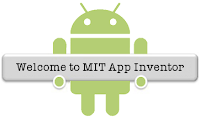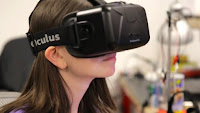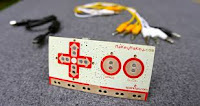Today marked week 3 of our 20% time / genius hour project. The learning space was a buzz during my three 8th grade game design and development elective courses. Kids are settling into the idea but it is still new to them so class starts with a bit of confusion until everyone is actively engaged in their project. I see this diminishing already and anticipate that over the next few weeks kids will come right in and get started without knowing whether or not I am even there :)
It's very interesting to truly put the learning in the students hands. There is an inclination for students to want (dare I say expect) a lot of attention when they don't know exactly what to do. The true humor (after the fact) comes in watching them fumble because they cannot figure out how to turn on the TV or set up the right input on the TV to connect to the device they are working with. It literally took a pair of students 20 minutes (and a few hints from me although I was VERY stingy in giving assistance) to get the raspberry pi connected and showing up on one of the TVs in the room. Ultimately a third student came to their aid. It was little things like the TV input, needing to take the HDMI cable out of the Xbox360 to use it with the pi, but the best was the fact that they tried to plug the mini usb into the Ethernet port in the raspberry pi and wondered why it wasn't powering up. This is one of those moments when you really want to help them but need to let go and embrace the learning that is taking place through the process. After all, if these kids got a raspberry pi in the mail they would be sure to figure out how to get it hooked up at home without my assistance.
Some of the happenings around the room included students making progress with their watch it build it projects. To get oriented to the chosen technology or tool, students were tasked with finding a tutorial (video or print) to guide them to use the tool to recreate something. There were kids programming in project spark to get dragons to fight back if attacked by their player. That was pretty cool to see! Other kids were building worlds and racetracks in Disney Infinity. Several teams using the raspberry pi (once they got it connected to the TV) were programming in python and celebrating the fruits of their labor. Anyone who programs can attest to the fact that it is pretty gratifying to see "Hello, World" displayed on a screen when you were responsible for typing and executing the code. Other students were working with MIT App Inventor, makeymakey, XCode, Twine, and a variety of other tools.
I'd like to close today's post with some responses to a reflection question posed to the kids. When students were choosing the tool they would like to use, they were asked to respond to the question:
What do you think about the idea of extending your learning on your own in order to truly take learning into your own hands?
Most of the responses were great. I will share some now and continue to sprinkle them in here and there through the year...
Extending learning on my own is important. It teaches students to be resourceful and test and look for solutions on their own. Taking learning into my own hands means that there are no guidelines I must follow, and it gives me lots of creative options to pursue as I learn on my own. There are lots of possibilities for learning when it is directed only by the creator's mind, and two people who both have similar ideas in the beginning may have different creative directions and different final products.
The idea of extending our learning on our own is exciting because then we can work at our own pace and not be held back or left behind.
It is an interesting challenge. It requires you to be motivated. You will also need to be more creative than just following instructions.
I think that doing so will help us learn responsibility and it will let us take things that truely interest us and will motivate us to continue working and give it our best effort.
I'll stop there for now. I hope you are enjoying following along on our journey. I am a huge proponent of choice / passion based learning and see this project as a great opportunity to empower students in the process









